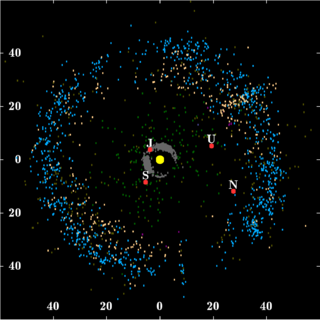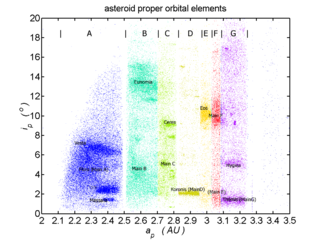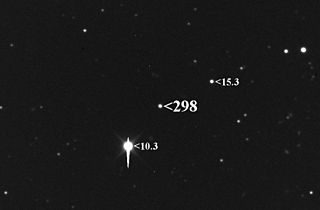
main-belt asteroids, and
Hungaria asteroids
The E-belt asteroids were the population of a hypothetical extension of the primordial asteroid belt proposed as the source of most of the basin-forming lunar impacts during the Late Heavy Bombardment. [1]

The E-belt asteroids were the population of a hypothetical extension of the primordial asteroid belt proposed as the source of most of the basin-forming lunar impacts during the Late Heavy Bombardment. [1]
The E-belt model was developed by William F. Bottke, David Vokrouhlicky, David Minton, David Nesvorný, Alessandro Morbidelli, Ramon Brasser, Bruce Simonson and Harold Levison. [1] It describes the dynamics of an inner band of the early asteroid belt within the framework of the Nice model.
The extended-belt asteroids were located between the current inner boundary of the asteroid belt and the orbit of Mars with semi-major axis ranging from 1.7 to 2.1 astronomical units (AU). In the current Solar System most orbits in this region are unstable due to the presence of the ν6 secular resonance. [1] However, prior to the giant planet migration described in the Nice model the outer planets would have been in a more compact configuration with nearly circular orbits. [2] With the planets in this configuration the ν6 secular resonance would be located outside the asteroid belt. [3] Stable orbits would have existed inside 2.1 AU and the inner edge of the primordial asteroid belt would have been defined by Mars-crossing orbits. [4]
During the migration of the giant planets the ν6 secular resonance would have moved inward as Saturn moved outward. [5] Upon reaching its current location near 2.1 AU the ν6 secular resonance and other related resonances would destabilize the orbits of the E-belt asteroids. Most would be driven onto planet-crossing orbits as their eccentricities and inclinations increased. Over a period of 400 million years impacts of the E-belt asteroids yield an estimated 9-10 of the 12 basin-forming lunar impacts attributed to the Late Heavy Bombardment. [1]
As their orbits evolved many of the E-belt asteroids would have acquired orbits similar to those of the Hungaria asteroids with high inclinations and semimajor axis between 1.8 and 2.0 AU. [6] Because orbits in this region are dynamically sticky these objects would form a quasi-stable reservoir. [1] As this population of the E-belt asteroids leaked from this reservoir they would produce a long-lived tail of impacts after the traditional end of the late heavy bombardment at 3.7 billion years ago. [7] A remnant representing roughly 0.1–0.4% of the original E-belt asteroids would remain as the current Hungaria asteroids. [1]
Evidence for the Moon does not support comets from the outer planetesimal belt as the source of the basin-forming lunar impacts. The size frequency distribution (SFD) of ancient lunar craters is a similar to the SFD of main belt asteroids instead of that of comets. [4] Samples recovered from the Moon containing impact melts have a range of ages rather than the sharp spike expected if comets produced the LHB. [8] Analysis of highly siderophile elements in these samples shows a better match for impactors from the inner Solar System than for comets. [8] Studies of the dynamics of the main asteroid belt during giant planet migration have significantly limited the number of impactors originating from this region. A rapid alteration of Jupiter's and Saturn's orbits is necessary to reproduce the current orbital distribution. [3] This scenario removes only 50% of the asteroids from the main belt producing 2–3 basins on the Moon. [4]
Examination of samples recovered from the Moon indicates that the impactors were thermally evolved objects. [6] E-type asteroids, an example of this type, are uncommon in the main belt [9] but become more common toward the inner belt and would be expected to be most common in the E-belt. [6] The Hungaria asteroids, which are a remnant of the E-belt in this model, contain a sizable fraction of E-type asteroids. [10]
The decay of the population of E-belt asteroids captured onto Hungaria like orbits produces a long-lived tail of impacts which continues past the LHB. The continuation of the bombardment is predicted to generate basin-forming impacts on the Earth and Chicxulub-sized craters on the Earth and Moon. [1] Impact craters on the Moon and impact spherule beds found on the Earth dated to this period are consistent with these predictions. [1]
The E-belt model predicts a remnant population will remain on Hungaria-like orbits. The initial population of E-belt asteroids was calculated based on the population of potential basin-forming impactors remaining among the Hungaria asteroids. [8] The result was consistent with calculations based on the recent estimates of the orbital density of the main asteroid belt before the planetary migration. [4]

The Kuiper belt is a circumstellar disc in the outer Solar System, extending from the orbit of Neptune at 30 astronomical units (AU) to approximately 50 AU from the Sun. It is similar to the asteroid belt, but is far larger—20 times as wide and 20–200 times as massive. Like the asteroid belt, it consists mainly of small bodies or remnants from when the Solar System formed. While many asteroids are composed primarily of rock and metal, most Kuiper belt objects are composed largely of frozen volatiles, such as methane, ammonia, and water. The Kuiper belt is home to most of the objects that astronomers generally accept as dwarf planets: Orcus, Pluto, Haumea, Quaoar, and Makemake. Some of the Solar System's moons, such as Neptune's Triton and Saturn's Phoebe, may have originated in the region.

The asteroid belt is a torus-shaped region in the Solar System, centered on the Sun and roughly spanning the space between the orbits of the planets Jupiter and Mars. It contains a great many solid, irregularly shaped bodies called asteroids or minor planets. The identified objects are of many sizes, but much smaller than planets, and, on average, are about one million kilometers apart. This asteroid belt is also called the main asteroid belt or main belt to distinguish it from other asteroid populations in the Solar System.

A Kirkwood gap is a gap or dip in the distribution of the semi-major axes of the orbits of main-belt asteroids. They correspond to the locations of orbital resonances with Jupiter.
2598 Merlin, provisional designation 1980 RY, is a carbonaceous Dorian asteroid from the central regions of the asteroid belt, approximately 16 kilometers in diameter. It was discovered on 7 September 1980, by American astronomer Edward Bowell at Lowell's Anderson Mesa Station in Flagstaff, Arizona, United States. The asteroid was named after the legendary wizard Merlin in Arthurian legend.

Hecuba is a fairly large and bright main-belt asteroid. It was discovered by Karl Theodor Robert Luther on 2 April 1869, and named after Hecuba, wife of King Priam in the legends of the Trojan War in Greek Mythology. This object is orbiting the Sun with a period of 5.83 years and an eccentricity of 0.06. It became the first asteroid discovered to orbit near a 2:1 mean-motion resonance with the planet Jupiter, and is the namesake of the Hecuba group of asteroids.

An asteroid family is a population of asteroids that share similar proper orbital elements, such as semimajor axis, eccentricity, and orbital inclination. The members of the families are thought to be fragments of past asteroid collisions. An asteroid family is a more specific term than asteroid group whose members, while sharing some broad orbital characteristics, may be otherwise unrelated to each other.
Planet V is a hypothetical fifth terrestrial planet posited by NASA scientists John Chambers and Jack J. Lissauer to have once existed between Mars and the asteroid belt. In their hypothesis the Late Heavy Bombardment of the Hadean era began after perturbations from the other terrestrial planets caused Planet V's orbit to cross into the asteroid belt. Chambers and Lissauer presented the results of initial tests of this hypothesis during the 33rd Lunar and Planetary Science Conference, held from March 11 through 15, 2002.

832 Karin is a minor planet orbiting the Sun. It is the largest and brightest member of the Karin Cluster, which is named after it. Found in 2002, the Karin cluster is notable for being very young. It is currently believed to have formed in a collision only 5.8 million years ago.
The Massalia family is a family of asteroids in the inner asteroid belt, named after its parent body, 20 Massalia. It consists of S-type asteroids with very low inclinations, straddling the 1:2 resonances with Mars. There are more than 6,000 known Massalian asteroids.
4354 Euclides, provisional designation 2142 P-L, is a dark Dorian asteroid from the central regions of the asteroid belt, approximately 12 kilometers in diameter. It was discovered on 24 September 1960, by Dutch astronomer couple Ingrid and Cornelis van Houten on photographic plates taken by Dutch–American astronomer Tom Gehrels at Palomar Observatory in California. The likely C-type asteroid was named after the Greek mathematician Euclid.
The Hungaria asteroids, also known as the Hungaria group, are a dynamical group of asteroids in the asteroid belt which orbit the Sun with a semi-major axis between 1.78 and 2.00 astronomical units (AU). They are the innermost dense concentration of asteroids in the Solar System—the near-Earth asteroids are much more sparse—and derive their name from their largest member 434 Hungaria. The Hungaria group includes the Hungaria family, a collisional asteroid family which dominates its population.

The Baptistina family is an asteroid family of more than 2500 members that was probably produced by the breakup of an asteroid 170 km (110 mi) across 80 million years ago following an impact with a smaller body. The two largest presumed remnants of the parent asteroid are main-belt asteroids 298 Baptistina and 1696 Nurmela. The Baptistina family is part of the larger Flora clan. It was briefly speculated that the Chicxulub impactor was part of the Baptistina family of asteroids, but this was disproven in 2011 using data from the Wide-field Infrared Survey Explorer (WISE).
William F. "Bill" Bottke is a planetary scientist specializing in asteroids. He works at the Southwest Research Institute in Boulder, Colorado.

The Nicemodel is a scenario for the dynamical evolution of the Solar System. It is named for the location of the Côte d'Azur Observatory—where it was initially developed in 2005—in Nice, France. It proposes the migration of the giant planets from an initial compact configuration into their present positions, long after the dissipation of the initial protoplanetary disk. In this way, it differs from earlier models of the Solar System's formation. This planetary migration is used in dynamical simulations of the Solar System to explain historical events including the Late Heavy Bombardment of the inner Solar System, the formation of the Oort cloud, and the existence of populations of small Solar System bodies such as the Kuiper belt, the Neptune and Jupiter trojans, and the numerous resonant trans-Neptunian objects dominated by Neptune.

The Late Heavy Bombardment (LHB), or lunar cataclysm, is a hypothesized event thought to have occurred approximately 4.1 to 3.8 billion years (Ga) ago, at a time corresponding to the Neohadean and Eoarchean eras on Earth. According to the hypothesis, during this interval, a disproportionately large number of asteroids and comets collided with the early terrestrial planets in the inner Solar System, including Mercury, Venus, Earth and Mars. These came from both post-accretion and planetary instability-driven populations of impactors. Although it used to be widely accepted, it remained difficult to provide an overwhelming amount of evidence for the hypothesis. However, recent re-appraisal of the cosmo-chemical constraints indicates that there was likely no late spike in the bombardment rate.
The five-planet Nice model is a numerical model of the early Solar System that is a revised variation of the Nice model. It begins with five giant planets, the four that exist today plus an additional ice giant between Saturn and Uranus in a chain of mean-motion resonances.
The jumping-Jupiter scenario specifies an evolution of giant-planet migration described by the Nice model, in which an ice giant is scattered inward by Saturn and outward by Jupiter, causing their semi-major axes to jump, quickly separating their orbits. The jumping-Jupiter scenario was proposed by Ramon Brasser, Alessandro Morbidelli, Rodney Gomes, Kleomenis Tsiganis, and Harold Levison after their studies revealed that the smooth divergent migration of Jupiter and Saturn resulted in an inner Solar System significantly different from the current Solar System. During this migration secular resonances swept through the inner Solar System exciting the orbits of the terrestrial planets and the asteroids, leaving the planets' orbits too eccentric, and the asteroid belt with too many high-inclination objects. The jumps in the semi-major axes of Jupiter and Saturn described in the jumping-Jupiter scenario can allow these resonances to quickly cross the inner Solar System without altering orbits excessively, although the terrestrial planets remain sensitive to its passage.
The Nice 2 model is a model of the early evolution of the Solar System. The Nice 2 model resembles the original Nice model in that a late instability of the outer Solar System results in gravitational encounters between planets, the disruption of an outer planetesimal disk, and the migrations of the outer planets to new orbits. However, the Nice 2 model differs in its initial conditions and in the mechanism for triggering the late instability. These changes reflect the analysis of the orbital evolution of the outer Solar System during the gas disk phase and the inclusion of gravitational interactions between planetesimals in the outer disk into the model.
Bruce Simonson is an American planetary scientist and geologist notable for his contributions to meteoroid astronomy and glaciology. He is credited as one of the foremost experts in glacial till plains as well as one of the developers of the E-belt model. He has served as professor of geology at Oberlin College since 1979.

In planetary astronomy, the grand tack hypothesis proposes that Jupiter formed at a distance of 3.5 AU from the Sun, then migrated inward to 1.5 AU, before reversing course due to capturing Saturn in an orbital resonance, eventually halting near its current orbit at 5.2 AU. The reversal of Jupiter's planetary migration is likened to the path of a sailboat changing directions (tacking) as it travels against the wind.